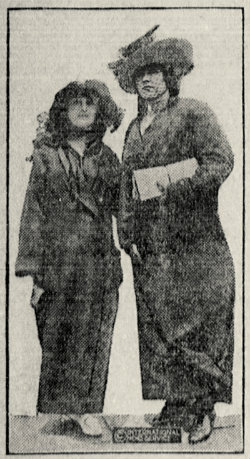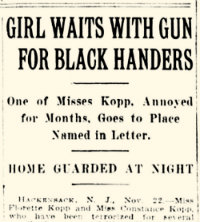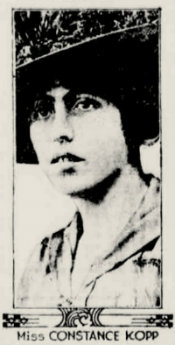Summary | Excerpt | Reading Guide | Discuss | Reviews | Beyond the Book | Read-Alikes | Genres & Themes | Author Bio

Critics' Opinion:
Readers' Opinion:
First Published:
Sep 2015, 416 pages
Paperback:
May 2016, 448 pages
 Book Reviewed by:
Book Reviewed by:
BookBrowse First Impression Reviewers
Buy This Book
This article relates to Girl Waits with Gun
Girl Waits With Gun is historical fiction based on the true-life accounts of the Kopp sisters of New Jersey, whose lives were irrevocably changed after one roadside incident when their horse-driven buggy was damaged by a car.
The car's owner, Henry Kaufman, was a local industrialist who, along with his brother, owned a silk dyeing plant in Paterson, NJ. Refusing to acknowledge the accident and pay the damages, Kaufman instead chose to terrorize the sisters, sending them death threats by mail and generally harassing them for the better portion of a year.
 Constance, the oldest of the three, who according to newspaper accounts stood six feet tall and weighed close to 180 pounds, decided enough was enough and teamed up with the local sheriff to bring a case against Kaufman to court and get justice delivered. In the beginning of the ordeal, the women also took to guarding their house with guns after numerous threats were received. In fact, the book's title is derived from the headline of a newspaper article "Girl Waits With Gun," which described Constance waiting around a street corner with a gun in her handbag to catch the man who had been such a source of mental anguish for her family.
Constance, the oldest of the three, who according to newspaper accounts stood six feet tall and weighed close to 180 pounds, decided enough was enough and teamed up with the local sheriff to bring a case against Kaufman to court and get justice delivered. In the beginning of the ordeal, the women also took to guarding their house with guns after numerous threats were received. In fact, the book's title is derived from the headline of a newspaper article "Girl Waits With Gun," which described Constance waiting around a street corner with a gun in her handbag to catch the man who had been such a source of mental anguish for her family.
 According to research and family accounts put together by Amy Stewart, Constance Kopp was born in Brooklyn in 1878 and must have been 35 years old at the time of the accident. A strong and independent-minded woman who spoke French and two dialects of German, she was a product of her time in history, her ambitions of becoming either a nurse or a lawyer thwarted by her mother's will that she not do so. Haunted by secrets of her own, she once told a reporter that she had no interest in marriage which pretty much meant a life spent at home. "Some women prefer to stay at home and take care of the house. Let them. There are plenty who like that kind of work enough to do it," she said, "Others want something to do that will take them out among people and affairs. A woman should have the right to do any sort of work she wants to, provided she can do it." In the end, Constance proved she could do precisely that, the buggy accident eventually determining the course of her career as one of the country's first woman deputy sheriffs.
According to research and family accounts put together by Amy Stewart, Constance Kopp was born in Brooklyn in 1878 and must have been 35 years old at the time of the accident. A strong and independent-minded woman who spoke French and two dialects of German, she was a product of her time in history, her ambitions of becoming either a nurse or a lawyer thwarted by her mother's will that she not do so. Haunted by secrets of her own, she once told a reporter that she had no interest in marriage which pretty much meant a life spent at home. "Some women prefer to stay at home and take care of the house. Let them. There are plenty who like that kind of work enough to do it," she said, "Others want something to do that will take them out among people and affairs. A woman should have the right to do any sort of work she wants to, provided she can do it." In the end, Constance proved she could do precisely that, the buggy accident eventually determining the course of her career as one of the country's first woman deputy sheriffs.
 The middle sister, Norma, was also born in Brooklyn and was 31 at the time of the incident. While no pictures of her survive, family members describe her as stubborn and highly opinionated, not an easy person to get along with. Her obituary described her as a "huntswoman very capable with guns" and "fearless."
The middle sister, Norma, was also born in Brooklyn and was 31 at the time of the incident. While no pictures of her survive, family members describe her as stubborn and highly opinionated, not an easy person to get along with. Her obituary described her as a "huntswoman very capable with guns" and "fearless."
Born in 1897, the youngest sister Fleurette Eugenie Kopp was only sixteen at the time of the accident. A talented seamstress who always made her own clothes, she would later sew patterns from Vogue and work as a private tailor, crafting wardrobes for wealthy women. Five feet tall in heels, she stood in sharp contrast to her oldest sister, Constance. Like Constance and Norma too, Fleurette spoke French and German fluently. As a teenager Fleurette was involved in local theater and entered a few singing contests around Paterson, New Jersey.
The Kopp sisters' brand of vigilante justice made national headlines at the time even if history seems to have mostly forgotten them.
Pictures from author's website
Filed under People, Eras & Events
![]() This "beyond the book article" relates to Girl Waits with Gun. It originally ran in September 2015 and has been updated for the
May 2016 paperback edition.
Go to magazine.
This "beyond the book article" relates to Girl Waits with Gun. It originally ran in September 2015 and has been updated for the
May 2016 paperback edition.
Go to magazine.





The Flower Sisters
by Michelle Collins Anderson
From the new Fannie Flagg of the Ozarks, a richly-woven story of family, forgiveness, and reinvention.

The House on Biscayne Bay
by Chanel Cleeton
As death stalks a gothic mansion in Miami, the lives of two women intertwine as the past and present collide.

The Funeral Cryer by Wenyan Lu
Debut novelist Wenyan Lu brings us this witty yet profound story about one woman's midlife reawakening in contemporary rural China.
Your guide toexceptional books
BookBrowse seeks out and recommends the best in contemporary fiction and nonfiction—books that not only engage and entertain but also deepen our understanding of ourselves and the world around us.